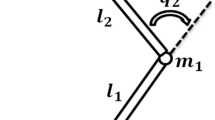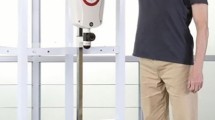Abstract
Upper Limb Rehabilitation Robots (ULRR) for the patient having shoulder and elbow joint movement disorders, requires further study for development. One aspect that must be fulfilled by such robots, is the need to handle uncertainties due to biomechanical variation of different patients, without significantly degrading performance. Currently, rehabilitation robots require re-tuning of controller gain for each individual. This is time consuming process and requires expert training. To overcome this problem, we propose robust sliding mode control algorithm, which uses very basic information of subject like weight, height, age and gender to handle these model uncertainties. For analysis, we have compared our proposed algorithm with Robust Computed Torque Control (RCTC) and Boundary Augmented Sliding Mode Control (BASMC) algorithms with diverse subjects. Results describe the superiority of the proposed algorithm in handling uncertain parameters human arm and robot without degrading the performance.
Similar content being viewed by others
Abbreviations
- RCTC:
-
Robust Computed Torque Control
- BASMC:
-
Boundary Augmented Sliding Mode Control
- RSMC:
-
Robust Sliding Mode Control
- ULRR:
-
Upper Limb Rehabilitation Robot
References
Mozaffarian, D., Benjamin, E. J., Go, A. S., Arnett, D. K., Blaha, M. J., et al., “Executive Summary: Heart Disease and Stroke Statistics-2015 Update: A Report from the American Heart Association,” Circulation, Vol. 131, No. 4, pp. 434, 2015.
Barreca, S., Wolf, S. L., Fasoli, S., and Bohannon, R., “Treatment Interventions for the Paretic Upper Limb of Stroke Survivors: A Critical Review,” Neurorehabilitation and Neural Repair, Vol. 17, No. 4, pp. 220–226, 2003.
Feys, H. M., De Weerdt, W. J., Selz, B. E., Steck, G. A. C., Spichiger, R., et al., “Effect of a Therapeutic Intervention for the Hemiplegic Upper Limb in the Acute Phase after Stroke a Single-Blind, Randomized, Controlled Multicenter Trial,” Stroke, Vol. 29, No. 4, pp. 785–792, 1998.
Kwakkel, G., Wagenaar, R. C., Twisk, J. W., Lankhorst, G. J., and Koetsier, J. C., “Intensity of Leg and Arm Training after Primary Middle-Cerebral-Artery Stroke: A Randomised Trial,” The Lancet, Vol. 354, No. 9174, pp. 191–196, 1999.
Zhang, J. and Cheah, C. C., “Passivity and Stability of Human-Robot Interaction Control for Upper-Limb Rehabilitation Robots,” IEEE Transactions on Robotics, Vol. 31, No. 2, pp. 233–245, 2015.
Choi, J. H., Shin, D. H., Park, T. S., Jeong, C. P., Moon, J. I., and An, J. N., “Kinematic Design Consideration based on Actuator Placement of Five-Bar Planar Robot for Arm Rehabilitation,” Key Engineering Materials, Vol. 625, pp. 638–643, 2014.
Martin, P. and Emami, M. R., “A Neuro-Fuzzy Approach to Real-Time Trajectory Generation for Robotic Rehabilitation,” Robotics and Autonomous Systems, Vol. 62, No. 4, pp. 568–578, 2014.
Rahman, M. H., Saad, M., Kenn, J.-P., and Archambault, P. S., “Control of an Exoskeleton Robot Arm with Sliding Mode Exponential Reaching Law,” International Journal of Control, Automation and Systems, Vol. 11, No. 1, pp. 92–104, 2013.
Ueda, J., Ming, D., Krishnamoorthy, V., Shinohara, M., and Ogasawara, T., “Individual Muscle Control using an Exoskeleton Robot for Muscle Function Testing,” IEEE Transactions on Neural Systems and Rehabilitation Engineering, Vol. 18, No. 4, pp. 339–350, 2010.
Ugurlu, B., Nishimura, M., Hyodo, K., Kawanishi, M., and Narikiyo, T., “Proof of Concept for Robot-Aided Upper Limb Rehabilitation using Disturbance Observers,” IEEE Transactions on Human-Machine Systems, Vol. 45, No. 1, pp. 110–118, 2015.
Wu, C., Song, A., Li, H., Xu, B., Xu, X., et al., “Upper Limb Rehabilitation Training Robot and Its Control Method,” Chinese Journal of Scientific Instrument, Vol. 35, No. 5, pp. 999–1004, 2014.
Kwakkel, G., Kollen, B. J., and Krebs, H. I., “Effects of Robot-Assisted Therapy on Upper Limb Recovery after Stroke: A Systematic Review,” Neurorehabilitation and Neural Repair, DOI No. 10.1177/1545968307305457, 2007.
Lee, H., Kim, W., Han, J., and Han, C., “The Technical Trend of the Exoskeleton Robot System for Human Power Assistance,” Int. J. Precis. Eng. Manuf., Vol. 13, No. 8, pp. 1491–1497, 2012.
Kim, H.-M. and Kim, G.-S., “Development of a Finger-Rehabilitation Robot for Fingers’ Flexibility Rehabilitation Exercise,” Int. J. Precis. Eng. Manuf., Vol. 14, No. 4, pp. 535–541, 2013.
Kim, J.-Y., Yang, U.-J., and Park, K., “Design, Motion Planning and Control of Frozen Shoulder Rehabilitation Robot,” Int. J. Precis. Eng. Manuf., Vol. 15, No. 9, pp. 1875–1881, 2014.
Babaiasl, M., Mahdioun, S. H., Jaryani, P., and Yazdani, M., “A Review of Technological and Clinical Aspects of Robot-Aided Rehabilitation of Upper-Extremity after Stroke,” Disability and Rehabilitation: Assistive Technology, DOI No. 10.3109/17483107. 2014.1002539, 2015.
Nef, T., Mihelj, M., and Riener, R., “Armin: A Robot for Patient-Cooperative Arm Therapy,” Medical & Biological Engineering & Computing, Vol. 45, No. 9, pp. 887–900, 2007.
Yu, W. and Rosen, J., “A Novel Linear Pid Controller for an Upper Limb Exoskeleton,” Proc. of 49th IEEE Conference on Decision and Control (CDC), pp. 3548–3553, 2010.
Rahman, M., Rahman, M., Cristobal, O., Saad, M., Kenn, J., and Archambault, P., “Development of a Whole Arm Wearable Robotic Exoskeleton for Rehabilitation and to Assist Upper Limb Movements,” Robotica, Vol. 33, No. 1, pp. 19–39, 2015.
Spong, M. W., Hutchinson, S., and Vidyasagar, M., “Robot Modeling and Control,” Wiley New York, pp. 289–311, 2006.
Hill, J. and Fahimi, F., “Active Disturbance Rejection for Walking Bipedal Robots using the Acceleration of the Upper Limbs,” Robotica, Vol. 33, No. 2, pp. 264–281, 2015.
Guga, J., “Cyborg Tales: The Reinvention of the Human in the Information Age,” Beyond Artificial Intelligence, Vol. 9, pp. 45–62, 2015.
Jiang, X., Wang, Z., Zhang, C., and Yang, L., “Fuzzy Neural Network Control of the Rehabilitation Robotic Arm Driven by Pneumatic Muscles,” Industrial Robot: An International Journal, Vol. 42, No. 1, pp. 36–43, 2015.
Otten, A., Voort, C., Stienen, A., Aarts, R., van Asseldonk, E., and Kooij, H., “LIMPACT: A Hydraulically Powered Self-Aligning Upper Limb Exoskeleton,” IEEE/ASME Transactions on Mechatronics, Vol. 20, No. 5, pp. 2285–4435, 2015.
Slotine, J.-J. E. and Li, W., “Applied Nonlinear Control,” Prentice-Hall Englewood Cliffs, pp. 276–299, 1991.
Wicke, J. and Dumas, G. A., “A New Geometric-based Model to Accurately Estimate Arm and Leg Inertial Estimates,” Journal of Biomechanics, Vol. 47, No. 8, pp. 1869–1875, 2014.
Winter, D. A., “Biomechanics and Motor Control of Human Movement,” John Wiley & Sons, pp. 82–103, 2009.
Author information
Authors and Affiliations
Corresponding author
Rights and permissions
About this article
Cite this article
Yun, D., Khan, A.M., Yan, RJ. et al. Handling subject arm uncertainties for upper limb rehabilitation robot using robust sliding mode control. Int. J. Precis. Eng. Manuf. 17, 355–362 (2016). https://doi.org/10.1007/s12541-016-0044-6
Received:
Revised:
Accepted:
Published:
Issue Date:
DOI: https://doi.org/10.1007/s12541-016-0044-6




